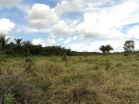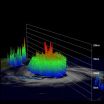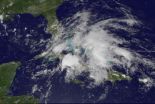(Press-News.org) WEST LAFAYETTE, Ind. - Researchers have developed a new type of imaging technology to diagnose cardiovascular disease and other disorders by measuring ultrasound signals from molecules exposed to a fast-pulsing laser.
The new method could be used to take precise three-dimensional images of plaques lining arteries, said Ji-Xin Cheng, an associate professor of biomedical engineering and chemistry at Purdue University.
Other imaging methods that provide molecular information are unable to penetrate tissue deep enough to reveal the three-dimensional structure of the plaques, but being able to do so would make better diagnoses possible, he said.
"You would have to cut a cross section of an artery to really see the three-dimensional structure of the plaque," Cheng said. "Obviously, that can't be used for living patients."
The imaging reveals the presence of carbon-hydrogen bonds making up lipid molecules in arterial plaques that cause heart disease. The method also might be used to detect fat molecules in muscles to diagnose diabetes and for other lipid-related disorders, including neurological conditions and brain trauma. The technique also reveals nitrogen-hydrogen bonds making up proteins, meaning the imaging tool also might be useful for diagnosing other diseases and to study collagen's role in scar formation.
"Being able to key on specific chemical bonds is expected to open a completely new direction for the field," Cheng said
Findings are detailed in a paper to be published in Physical Review Letters and expected to appear in the June 17 issue. The findings represent the culmination of four years of research led by Cheng and doctoral student Han-Wei Wang.
The new technique uses nanosecond laser pulses in the near-infrared range of the spectrum. The laser generates molecular "overtone" vibrations, or wavelengths that are not absorbed by the blood. The pulsed laser causes tissue to heat and expand locally, generating pressure waves at the ultrasound frequency that can be picked up with a device called a transducer.
"We are working to miniaturize the system so that we can build an endoscope to put into blood vessels using a catheter," Cheng said. "This would enable us to see the exact nature of plaque formation in the walls of arteries to better quantify and diagnose cardiovascular disease."
Lihong Wang, Gene K. Beare Distinguished Professor of Biomedical Engineering at Washington University in St. Louis, is a pioneer of using the "photoacoustic" imaging of blood vessels based on the absorption of light by the electrons in hemoglobin.
The Purdue researchers are the first to show that a strong photoacoustic signal can arise from the absorption of light by the chemical bonds in molecules. The near-infrared laser causes enough heating to generate ultrasound but not enough to damage tissue.
"You can measure the time delay between the laser and the ultrasound waves, and this gives you a precise distance, which enables you to image layers of the tissues for three-dimensional pictures," Cheng said. "You do one scan and get all the cross sections. Our initial target is cardiovascular disease, but there are other potential applications, including diabetes and neurological conditions."
The approach represents a major improvement over another imaging technique, called coherent anti-Stokes Raman scattering, or CARS, which has been used by the Purdue-based lab to study three-dimensional plaque formation in arteries.
Also leading the research are Michael Sturek, chair of the Department of Cellular and Integrative Physiology at the Indiana University School of Medicine; Robert P. Lucht, Purdue's Ralph and Bettye Bailey Professor of Combustion in Mechanical Engineering; and David Umulis, a Purdue assistant professor of agricultural and biological engineering. Other authors of the paper include Purdue graduate students Ning Chai, Pu Wang and Wei Dou and Washington University postdoctoral researcher Song Hu.
Findings are based on research with pig tissues in laboratory samples and also with live fruit flies.
"You can see fat inside fly larvae, representing the potential to study how obesity affects physiology in humans," Cheng said.
INFORMATION:
Research funding came from the National Institutes of Health and American Heart Association.
Writer: Emil Venere, 765-494-4709, venere@purdue.edu
Source: Ji-Xin Cheng, 765-494-4335, jcheng@purdue.edu
Related websites:
Ji-Xin Cheng: https://engineering.purdue.edu/BME/Research/Labs/Cheng
Purdue's Weldon School of Biomedical Engineering: http://www.purdue.edu/bme
IMAGE CAPTION:
Researchers have developed a new type of imaging technology to diagnose cardiovascular disease and other disorders by measuring ultrasound signals from chemical bonds in molecules exposed to a pulsing laser. This "vibrational photoacoustic" image shows plaque in an arterial wall. (Purdue University Weldon School of Biomedical Engineering image/Han-Wei Wang and Ji-Xin Cheng)
A publication-quality image is available at http://www.purdue.edu/uns/images/2011/cheng-vascular.jpg
Abstract on the research in this release is available at: http://www.purdue.edu/newsroom/research/2011/110609ChengVascular.html
New imaging tech promising for diagnosing cardiovascular disease, diabetes
2011-06-10
ELSE PRESS RELEASES FROM THIS DATE:
Ideal Casino Guide with a New Fresh Look
2011-06-10
Recently EiDealCasino.com has made some improvements to give their web site a fresh new look, which makes easier and more fun to surf.
EiDealCasino.com is a casino guide that assists Netherlands casino players to find top sites offering quality games that accept payments using the method iDeal - ideal casino guide.
Eidealcasino.com aims to make locating top online casinos, effortless. Their goal is to provide the best up-to-date information for Netherlands with various internet casinos. The website has gathered extensive information on the most reputable and popular ...
NASA catches system 92W become fifth NW Pacific tropical depression
2011-06-10
The low pressure system that has been bringing rainfall to the northwestern Philippines has strengthened into the fifth tropical depression of the Northwest Pacific Ocean's hurricane season.
Tropical Depression 05W (TD05W) also known as Dodong in the Philippines was caught by infrared NASA satellite imagery on June 8 at 1741 UTC (1:41 p.m. EDT). The infrared data showed some powerful thunderstorms with very cold cloud top temperatures near the threshold of AIRS data of -63 Fahrenheit and -52 Celsius. That indicates the coldest, strongest thunderstorms within the tropical ...
Advanced New eGreetings Website Launches
2011-06-10
An innovative new eGreetings website, www.iAttachments.com, officially opens for business today. For a $20 annual fee subscribers can send an unlimited number of greetings over the Internet. The distinctiveness of the service is 1) a short film with a song or a lyric video that tells a story appropriate for the greeting occasion, and 2) the core greeting is customized by the sender with an animated "envelope" preceding the film and an animated digital closing personalized with a message to the recipient follows
the film. Subscribers may also use the site's licensed ...
'Super varieties' of wheat expected to boost yields and block deadly threat to food security
2011-06-10
ST. PAUL, MN—Five years after the launch of a global effort to protect the world's most important food crop from variants of Ug99, a new and deadly form of wheat rust, scientists say they are close to producing super varieties of wheat that will resist the potent pathogen, while boosting yields by as much as 15 percent.
According to research to be presented at a global wheat rust symposium in Minneapolis starting June 13, scientists report that variants of the Ug99 strain of stem rust are becoming increasingly virulent and are being carried by wind beyond the handful of ...
Rebuilding The Amazon Rainforest One Tree at a Time
2011-06-10
What is Amazing Forest?
Yes, the Amazon rainforest is being cut down as you read this. 17% is already gone. The world's lungs - as it's referred to - is decreasing in size. Yes, everyone knows this. But what can we really do about it? The Amazing Forest is a chance to do something right from where you are, sitting in your chair, a few clicks and US$60 away.
Amazing Forest is the venue where people from all over the world are combining their efforts into one single strain to restore the Amazon rainforest to its original state.
We sell trees. Not trees to be delivered ...
NASA's infrared image of major Hurricane Adrian reveals its stormy life's blood
2011-06-10
Strong thunderstorms are the life's blood of tropical cyclones, and infrared and radar satellite data from NASA today confirms that the eastern Pacific Ocean's first hurricane has plenty of them and they're over 9 miles high. Adrian exploded in growth overnight from a tropical storm on June 8 to a major hurricane today.
NASA's Aqua satellite flew over Hurricane Adrian this morning at 8:29 UTC (1:59 a.m. EDT), and the Atmospheric Infrared Sounder instrument took an infrared snapshot of the storm's many strong thunderstorms and warm ocean water below.
The infrared data ...
Fragile X protein acts as toggle switch in brain cells
2011-06-10
New research shows how the protein missing in fragile X syndrome – the most common inherited form of intellectual disability – acts as a molecular toggle switch in brain cells.
The fragile X protein, called FMRP, hooks up with a group of molecules called microRNAs to switch the production of other proteins on and off in response to chemical signals, scientists at Emory University School of Medicine have discovered.
The results appear in the June 10 issue of Molecular Cell.
"For learning and memory to take place, neurons need to be able to make new proteins on demand, ...
Stretched-out low soaking the Caribbean in GOES-13 satellite imagery
2011-06-10
GOES-13 satellite imagery on June 9 shows that the pesky low pressure area in the north Caribbean Sea is stretching out and bringing soaking rains to Cuba, Hispaniola, Jamaica and Puerto Rico.
The Geostationary Operational Environmental Satellite called GOES-13 captured an image of this low on June 9 at 1740 UTC (1:40 p.m. EDT) System 94L, and the cloud cover appears centered over eastern Cuba and Jamaica while the outer portion of the low stretches over Hispaniola, Puerto Rico and now south Florida. The elongated low has a minimum central pressure of 1001 millibars and ...
Engaging high school students in soil science inquiry
2011-06-10
In April 2007, teacher Irka Elsevier and then-graduate student Biance Moebius-Clune began their second inquiry unit designed to enable high school students to better understand soil science concepts through their own research and experiments. Moebius-Clune was an NSF fellow in the Cornell Science Inquiry Partnerships (CSIP) program, which allowed the pair to develop inquiry curriculum to guide students through the process of doing research themselves.
Soil is fundamental to life and relevant to some of today's most pressing global issues, such as climate change and demand ...
NASA provides a 2-satellite view and video of the Chilean volcano eruption
2011-06-10
NASA's Aqua satellite and the GOES-13 satellite both captured their own unique views of the eruption of the Puyehue-Cordón Caulle volcano in Chile this week. One satellite provided a high-resolution image of the ash plume while the other provided a video showing the plumes movement over several days.
NASA's GOES Project released a satellite animation of the Puyehue-Cordón Caulle volcano that shows the movement of the ash plume over several days. The NASA GOES Project, located at NASA's Goddard Space Flight Center, Greenbelt, Md. created the animation from images obtained ...





